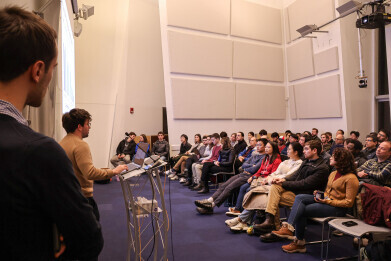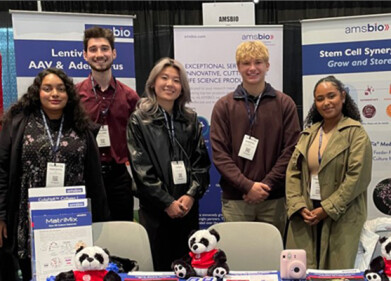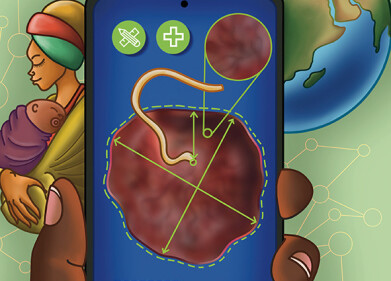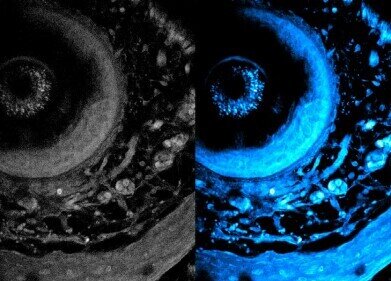-
 Gabriele Corso (left) and Jeremy Wohlwend (at podium) presented their new model at a Dec. 5 event at MIT’s Stata Center, where they said their ultimate goal is to foster global collaboration, accelerate discoveries, and provide a robust platform for advancing biomolecular modelling. Picture credit: Alex Ouyang, MIT
Gabriele Corso (left) and Jeremy Wohlwend (at podium) presented their new model at a Dec. 5 event at MIT’s Stata Center, where they said their ultimate goal is to foster global collaboration, accelerate discoveries, and provide a robust platform for advancing biomolecular modelling. Picture credit: Alex Ouyang, MIT
Research News
MIT teams take steps to democratise research with Boltz-1: a fully open-source AI model to predict biomolecular structures
Jan 02 2025
With models like AlphaFold3 limited to academic research, the team has built an equivalent alternative, to encourage broader innovation and participation
Scientists at Massachusetts Institute of Technology (MIT) have released a powerful, open-source AI model, called Boltz-1, that could significantly accelerate biomedical research and drug development.
Developed by a research team from MIT’s Jameel Clinic for Machine Learning in Health, Boltz-1 is the first fully open-source model that achieves state-of-the-art performance at an equivalent level to AlphaFold3, the model from Google DeepMind that can predict the 3D structures of biological molecules. DeepMind’s AlphaFold2, earned its pioneers Demis Hassabis and John Jumper the 2024 Nobel Prize in Chemistry.
The lead developers of Boltz-1MIT were graduate students Jeremy Wohlwend and Gabriele Corso, along with Saro Passaro, an MIT Jameel Clinic Research Affiliate and MIT professors of electrical engineering and computer science Regina Barzilay and Tommi Jaakkola.
Wohlwend and Corso presented the model at a December 5 event at MIT’s Stata Center, (pictured) where they said their ultimate goal is to foster global collaboration, accelerate discoveries, and provide a robust platform for advancing biomolecular modelling.
A protein’s shape is closely connected with its biological process and so understanding a protein’s structure is critical to new drug design, or to engineer new proteins that have specific functions. Accurately predicting the structure of proteins has been a major challenge for decades because of the complex process by which a protein’s long chain of amino acids folds into its 3D structure.
The AlphaFold3 machine learning model can rapidly predict the 3D structures of proteins so accurately that they are indistinguishable from experimentally derived results. The open-source model has been used by academic and commercial research teams around the world, spurring many advancements in drug development.
ILM WEBINAR SERIES 2025 – BOOK NOW
For their work on Boltz-1, the MIT team followed a similar initial approach as AlphaFold3, but after studying the underlying diffusion model, explored improvements that boosted accuracy by building algorithms that improved prediction efficiency.
Along with the model itself, they open-sourced their entire pipeline for training and fine-tuning so other scientists can build upon Boltz-1.
It took the MIT team four months of work, and many experiments, to develop Boltz-1. One of their biggest challenges was overcoming the ambiguity and heterogeneity contained in the Protein Data Bank, a collection of all biomolecular structures that thousands of biologists have solved in the past 70 years.
“I had a lot of long nights wrestling with these data. A lot of it is pure domain knowledge that one just has to acquire. There are no shortcuts,” Wohlwend says.
In the end, their experiments show that Boltz-1 attains the same level of accuracy as AlphaFold3 on a diverse set of complex biomolecular structure predictions.
The researchers plan to continue improving the performance of Boltz-1 and reduce the amount of time it takes to make predictions. They also invite researchers to try Boltz-1 on their GitHub repository and connect with fellow users of Boltz-1 on their Slack channel.
“We think there are still many, many years of work yet to improve these models. We are very eager to collaborate with others and see what the community does with this tool,” Wohlwend concluded.
This work was further supported by a U.S. National Science Foundation Expeditions grant; the Jameel Clinic; the U.S. Defense Threat Reduction Agency Discovery of Medical Countermeasures Against New and Emerging (DOMANE) Threats program; and the MATCHMAKERS project supported by the Cancer Grand Challenges partnership financed by Cancer Research UK and the U.S. National Cancer Institute.
For further reading visit: 10.1101/2024.11.19.624167
Digital Edition
Lab Asia 31.6 Dec 2024
December 2024
Chromatography Articles - Sustainable chromatography: Embracing software for greener methods Mass Spectrometry & Spectroscopy Articles - Solving industry challenges for phosphorus containi...
View all digital editions
Events
Jan 22 2025 Tokyo, Japan
Jan 22 2025 Birmingham, UK
Jan 25 2025 San Diego, CA, USA
Jan 27 2025 Dubai, UAE
Jan 29 2025 Tokyo, Japan


















